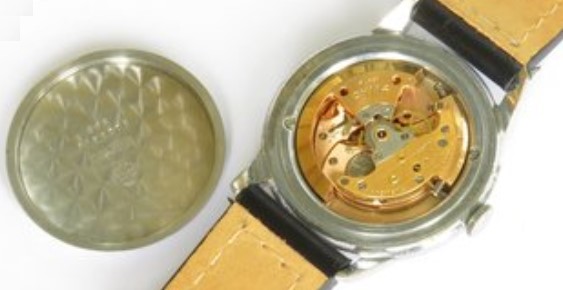Last Updated on June 29, 2024 by Jason
This vintage Cyma bumper automatic wrist watch exudes character. The Cyma brand is well-respected amongst vintage watch collectors. The watch, which dates from the 1950s has aged well and the watch keeps good time. The dial is branded Cymaflex, which was a proprietary shock protection system developed by Cyma in the late 1930s.

Cyma
Schwob Freres (Schwob Brothers) was founded in 1862 in La Chaux-de-Fonds by Joseph and Theodore Schwob as an etablisseur, an assembler of watches. They purchased ebauches (blank movements), cases, dials and hands and assembled these into watches. Schwob Freres trademarked several brand names over the years and developed an extensive overseas distribution network to market and sell their watches.
In 1891, the brothers went into partnership with a watchmaker called Henri-Frédéric Sandoz (1851-1913) who had created a new watch company, Tavannes, in the Jura municipality of the same name. Sandoz had originally started out running a watch manufacturing company in his name in 1870 in Le Locle. Henri departed from the company in 1889, for unknown reasons, and another family member, Jules Sandoz, continued the business. In 1891, Henri Sandoz set up a watchmaking company in Tavannes, a small municipality in the French-speaking canton of Bern in the Jura mountains.
Partnership
The partnership between Schwob Frères and Tavannes was mutually beneficial. Schwob Frères benefited from modern manufacturing processes and volumes. Tavannes benefited by being able to access the well-developed distribution network of Schwob Frères. Both of the companies remained separate entities and both exist in some form today.
In 1903, Schwob Frères registered the brand name Cyma pronounced “see-mah”. The name is derived either from the French word “cime”, meaning “crown” or from the Latin word “cyma”, meaning “sprouts”. By 1908, Cyma was advertising the resilience of their timepieces when exposed to electricity, magnetism and varying temperatures. Even basic models were very accurate and many were sold as officially tested chronometers.
Cyma R.420KT movement
The watch has a fully signed 17-jewel bumper automatic movement, calibre 420KT, which is working well. It is a Swiss made movement and was in production from 1943 until 1954. It is a variant of the 420 with a sweep second hand.

Calibre 420 was Cyma Tavannes first automatic movement. It was designed and built in-house by Cyma Tavannes. They had several variants, the basic being sub second then a sweep second and finally a variant with a date mechanism. They also made non-automatic versions of manual wind watches. The automatic movements are fastened to a mounting plate that varies in size depending on the case design.
Cyma calibre, 420 variants:
420: automatic, sub second
420KT: automatic, sweep second
424K: manual wind, sub second
425: automatic, sweep second, date
426KT: manual wind, sweep second
Cyma Tavannes calibre 420-425
- Made approximately: 1943-1954
- Made in Switzerland
- Power reserve: 30 hours
- 17 Jewels
Early automatic movements such as this one relied on the rotor ‘bumping’ backwards and forwards between two springs to maintain the power within the movement. Later automatic watches have a fully rotational rotor. The service history of this watch is unknown.
Dial and case
The watch measures 34mm in diameter excluding the winding crown and the lugs. The main body of the case is plated while the case back is stainless steel. There are minor marks but overall, the condition is excellent for a 1950s piece. The inside of the case back is signed with the Cyma name. The crystal lens is in near-mint condition, which is extremely good for a vintage watch.
The dial is signed with the Cyma logo, Cyma Automatic and Cymaflex. It has its original dauphine hands, seconds sweep and outer minute markers. There is light freckling across the dial, which is really only noticeable under magnification. A new leather strap has been fitted. Cymaflex (as indicated on the dial of this watch) was introduced by Cyma in 1939 as a protective device fitted over the balance to help absorb shocks. Specifically, Cymaflex protects against shock by placing a patented jewelled ‘cushion’ at each end of the balance staff, in a similar way to the Incabloc and Kif systems.
Summary
The 30-hour power reserve does seem to be a little on the low side. However, this is an automatic, so it shouldn’t really be a problem as long as it stays on the wrist. The watch passed a 24-hour timekeeping test with flying colours. It was -8 seconds over the day, which is more than acceptable for a vintage watch that is at least 70 years old. It looks great, and it keeps good time, what more can you ask for in a vintage watch?
Related content
What is a ‘Bumper’ watch movement? at Vintage Gold Watches.
Leave a Reply